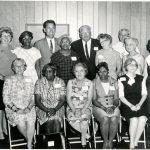REAL Services provides programs that promote nutrition, self-sufficiency, education, and protection for 30,000 people in northern Indiana each year.

The First Staff of Real Services, circa 1966
REAL Services, a nonprofit organization based in northern Indiana, has a rich history of serving and supporting community members in need. Founded in 1966 as Resources for Enriching Adult Living (REAL), the organization was established to address the growing demand for services for older adults in St. Joseph County, particularly those facing financial challenges.
Always an innovator, REAL Services created the first senior dining program offering older adults access to nutritious meals in a social setting, offering health and enrichment benefits. This first-of-its-kind program became the national model for the “Congregate Meal Program,” funded under the Older Americans Act. The Congregate Meal Program is offered in communities throughout the United States at community centers, senior centers, churches, or other accessible public venues.
As REAL Services established its reputation for meeting community needs, our role expanded. In 1974, we became the Area Agency on Aging, addressing the needs of individuals aged 60 and older and their caregivers. By 1985, we were designated a Community Action Agency, empowering and supporting people experiencing poverty.
Today, our mission is to support older adults and those facing financial challenges to live with independence, dignity, and resilience.
We envision a thriving, strong community where all residents have the opportunity to live productive, healthy lives and maintain their independence to the greatest extent possible.
Commitment to the Community
REAL Services has always maintained a strong connection to the community, working closely with local partners, government agencies, and volunteers to deliver its services. Our impact has grown significantly, serving more than 30,000 individuals and families across multiple counties in northern Indiana. This work would not be possible without the help of more than 2,000 volunteers who deliver meals, serve as guardian advocates, and help in numerous other ways to help us make such a significant impact on our community.
Continued Growth and Innovation
Over the decades, we continue to evolve, addressing emerging needs and expanding our programs. REAL Services remains dedicated to its founding principles while adapting to the changing landscape of social services and the specific needs of the populations we serve.
Commitment to the Community
REAL Services has always maintained a strong connection to the community, working closely with local partners, government agencies, and volunteers to deliver its services. Our impact has grown significantly, serving more than 30,000 individuals and families across multiple counties in northern Indiana. This work would not be possible without the help of more than 2,000 volunteers who deliver meals, serve as guardian advocates, and help in numerous other ways to help us make such a significant impact on our community.
Continued Growth and Innovation
Over the decades, we continue to evolve, addressing emerging needs and expanding our programs. REAL Services remains dedicated to its founding principles while adapting to the changing landscape of social services and the specific needs of the populations we serve.
